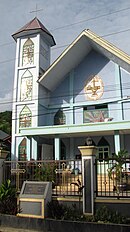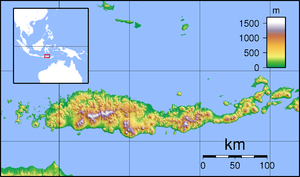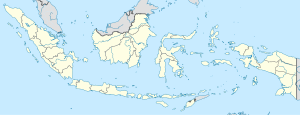|
Labuan Bajo
Labuan Bajo is a fishing town located at the western end of the large island of Flores in the East Nusa Tenggara province of Indonesia. It is in Komodo District.[2] It is the capital of the West Manggarai Regency, one of the eight regencies on Flores Island. ToponymyThe name Labuan Bajo is taken the town's harbour (labuan) and from the large number of Bajo tribes that live on the coast. TourismOnce a small fishing village, Labuan Bajo (also spelled Labuhanbajo and Labuanbajo) is now a tourist center as well as a centre of government for the surrounding region.[3]
Roads link Labuan Bajo to other towns across Flores such as Ruteng, Bajawa, Ende and Maumere.
Komodo National ParkLabuan Bajo is the gateway to the nearby Komodo National Park on and around Komodo Island and Rinca Island, both home to the famous Komodo dragons. The park is a World Heritage Site. Its islands offer good scuba diving. Every evening at Kalong Island (in the bay on the east side of Komodo island[9]), thousands of flying fox bats (burung kalong in Indonesian) rise from the mangroves and form a massive cloud that crosses the strait to Flores island in search of food. Diving sites near Labuan BajoThere are numerous diving sites in the islands close to Labuan Bajo - but in some places currents can be dangerously strong and much carefulness is required - notably at Batu Bolong site (whose name means "hole in the rock", in the Linta Strait), also called "Current City" for that reason[10][11] To the north are Sabolon kecil, Sabolon besar and Seraya kecil; to the west are Sebayur (outside Komodo park), Tatawa besar and Tatawa kechil (within the park[12]), Karang Makassar (Manta Point),[10] Kanawa,[13] Mauan,[14] The Cauldron[15] and many more.  Tourism developmentThe location of Labuan Bajo at the tip of Flores Island makes it the initial destination for incoming tourists.[16] It has been designated as a National Tourism Strategic Area (priority tourism destination) in the National Tourism Development Plan,[17] and as one of five super-priority tourism destinations established by the Indonesian Presidency[16] in 2018,[17] with an emphasis on providing essential tourism infrastructure and accommodation for visitors.[16] Facilities to support tourist activities are expanding quickly but the rapid rise in the numbers of visitors is imposing some strain on the local environment.[18] Thus accommodations have increased in the area: in 2019, it included 13 five-star hotels, 68 non-star hotels, 4 villas, and 26 dormitories.[19] This has considerably increased the built-up surface, with a growth of 161 ha between 2011 and 2017, another 246 ha between 2017 and 2023, and it is expected to grow by 267 ha again by 2029.[16] Tourism development has been further encouraged by the Indonesian Government declaring Labuan Bajo one of the "ten new Balis" and "five super priority tourism destinations" being developed to reduce the overtourism of Bali.[20] This is despite the fact that the area is prone to natural disasters, including tsunamis, earthquakes and landslides. These extreme natural phenomena are known to have a negative impact on the number of tourists and the tourist experience, and to have a greater influence on the number of tourists than man-made disasters such as terrorist attacks.[17]
The development of the area brings a mounting trash problem: the Komodo National Park and its surrounding area, including the coastal area of Labuan Bajo, can compile in one day an average of 13 tons of trash, of which 35 to 40 percent is inorganic waste that contains saleable plastic waste.[18] There are also the matters of illegal fishing and coral vulnerability,[18] while the basis of the decision regarding what is legal and illegal may be questioned: the local community has been fishing in these waters for centuries and did no damage; but since the creation of the national park they have been outlawed, and have been excluded from the decision-taking entities.[21] In the later part of 20th century, some fishermen did start using destructive methods such as explosives or chemicals; explosives are still used as of 2024.[22]
Stating that tourism development as having a great impact on the local economy[19] is certainly true, but not necessarily positive. A 2023 documentary by Dandhy Laksono has highlighted problems such as marginalization of local people, denial of indigenous peoples' rights, privatization of coastal areas and water resources, destruction of forests, control by big business players with strong political connections, and the resistance by residents to defend their living space. Thus tourism developments in Labuan Bajo offers little benefit to the local people; they are designed for outsiders and the interests of local residents are neglected. One tourist guide observed that "several corporations have obtained permits to open hotels and resorts over hundreds of hectares. One day big companies will control Komodo Island"; and he predicts that "ten years from now (2023), the Ata Modo indigenous people that inhabit Komodo Island will be reduced to living in cramped spaces."[23] Those people have lived on Komodo island for over a thousand years, but in the name of tourism development the gouvernment has declared them to be "wild settlers" and wants them out: in the national park, "There will be no human rights, only animal rights," says governor Victor Laiskodat[21] Which raises questions about the existence of the luxury Komodo resort[a] on Sebayur Besar island. One aspect of this tourism development is the increase of imbalance between the well-developed centre of Indonesia and its lesser developed periphery. Only one third of business owners are Florenese, and they mostly own small businesses with low margins who face the strongest competition, such as budget accommodations and tour operators. The large proportion of ownership by outsiders, in conjunction with these outsiders owning the businesses with the highest profits, presents a significant source of financial leakage.[27] This assessment was published in 2017. Since then the leakage situation has worsened: there has been the opening in September 2018 of the first five-star luxury resort Ayana Komodo (205 rooms), a Marriott hotel with the Ta'aktana resort, AccorHotels, Alila[28] and possibly others. Transport Komodo Airport is located just 2 km from the center of Labuan Bajo and has 4–6 daily flights arriving from Denpasar in Bali and elsewhere. Labuan Bajo port has daily ferry departures to the town of Bima to the west on the large island of Sumbawa and weekly or bi-weekly departures to Denpasar and Sulawesi. There are also direct flights from Jakarta by Garuda Indonesia and Batik Air. EconomyThe local economy in the town is centred around the ferry port and tourism, local shops and restaurants, and the scuba diving trade. Most of the foreign tourists are European, many from Italy, and also from Australia and the United Kingdom.[citation needed] The wider area produces fish and palm oil; there is also a large amount of subsistence agriculture in the villages in the region where living standards are still low. Levels of poverty in the rural areas are high. ClimateLabuan Bajo has a dry "winter" tropical savanna climate (Aw), with moderate to little rainfall from April to November and heavy rainfall from December to March.
Gallery
Notes
References
External linksWikimedia Commons has media related to Labuan Bajo.
|
||||||||||||||||||||||||||||||||||||||||||||||||||||||||||||||||||||||||||||||||||||||||||||||||||||||||||||||||||||||||||||||||||













